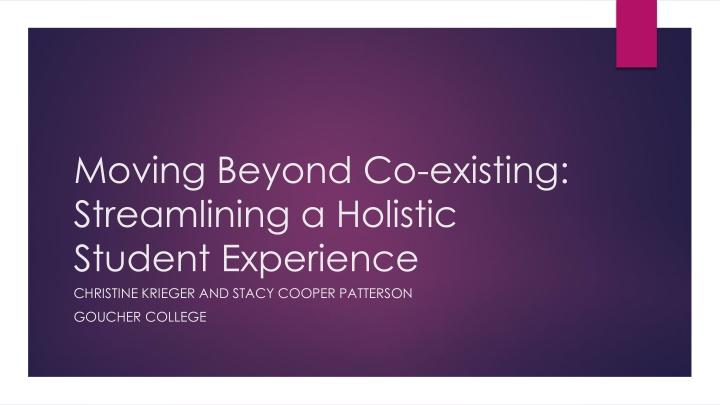
Streamlining the Holistic Student Experience at Goucher College
Discover how Goucher College is revolutionizing the student experience through a comprehensive program that focuses on mentorship, orientation, and academic support. Explore the history, challenges, and successes of their innovative approach to fostering a supportive learning environment for students.
Download Presentation

Please find below an Image/Link to download the presentation.
The content on the website is provided AS IS for your information and personal use only. It may not be sold, licensed, or shared on other websites without obtaining consent from the author. If you encounter any issues during the download, it is possible that the publisher has removed the file from their server.
You are allowed to download the files provided on this website for personal or commercial use, subject to the condition that they are used lawfully. All files are the property of their respective owners.
The content on the website is provided AS IS for your information and personal use only. It may not be sold, licensed, or shared on other websites without obtaining consent from the author.
E N D
Presentation Transcript
Moving Beyond Co-existing: Streamlining a Holistic Student Experience CHRISTINE KRIEGER AND STACY COOPER PATTERSON GOUCHER COLLEGE
Session Agenda Overview of Goucher College Overview of current program History The Years Student Leadership Model Lessons and Learnings
Goucher College Small, liberal arts college with 1500 students Just outside of Baltimore, MD Former women s institution PWI
The Basics First Year Experience involves three components, all facilitated by First Year Mentors (FYMs) Summer mentoring: FYMs email incoming students twice weekly about a scheduled topic Fall orientation: Four-day immersive experience that allows students to get comfortable with campus and each other First Year Experience course (FYE 134): Seven-week course covering a range of topics, including consent, community, identity and equity, and balance and moderation
Program History FYE started as two programs: Orientation and Connections Orientation included a five-day fall program, and it was crammed full of information Easy to recruit student leaders Connections was a 10-week course with a history of different types of instructors, credits, and topics Difficult to recruit student leaders Harmful to students with traditionally marginalized identities
Year One: So Many People, So Much Mess January is a hard time to start a new program for February Building trust can be tricky External pressure was intense But where s the budget?
Year One: So Many People, So Much Mess The Good Student leaders started to trust us, and they helped us with rebranding FYMs were able to support students emotionally The Bad Rebranding was largely unsuccessful with faculty and staff, and students still compared the program to Connections FYMs were overwhelmed Program not deemed a priority by the College Outside consultants had a singular focus
Year Two: Redemption The Good Two amazing student chairs Shortened class to seven weeks Cleaned up orientation Created gap year group The Bad So many white people Faculty and staff not onboard Figuring out transfer student experience FYMs walked out of training
Year Three: Refining The Good Very strong student leaders People forgot about Connections Tone change for recruitment New identity consultant The Bad Budgeting issues Party of one (and a half)
Year Four: Rebuilding The Good Young team that clicked Transfer mentor Solid curriculum The Bad Lots of new hands in the pot
Year Five: Joy and Engagement
Why Student Leaders? Peer leadership is instrumental in helping students as they transition Quick way for students to find upper division mentors Easier to relate to the student experience
Why This Model Works FYMs are passionate about helping other and investing in their own communities FYMs build trust with their groups throughout the summer and fall orientation, so its easier to tackle difficult topics We create a warm and welcoming environment for new students and their families FYMs are always ready to give us feedback
Challenges One FYM leaves every year Job is emotionally taxing for FYMs Students are teaching other students about identity and equity Others want to add more to FYM role Burden of retention
Lessons and Learnings Student leaders are great and challenging Changing campus culture takes a cycle of students Emotional labor is a huge component Remaining stagnant is never an option
Questions? Christine Krieger Christine.Krieger@goucher.edu Stacy Cooper Patterson Stacy.Patterson@goucher.edu
